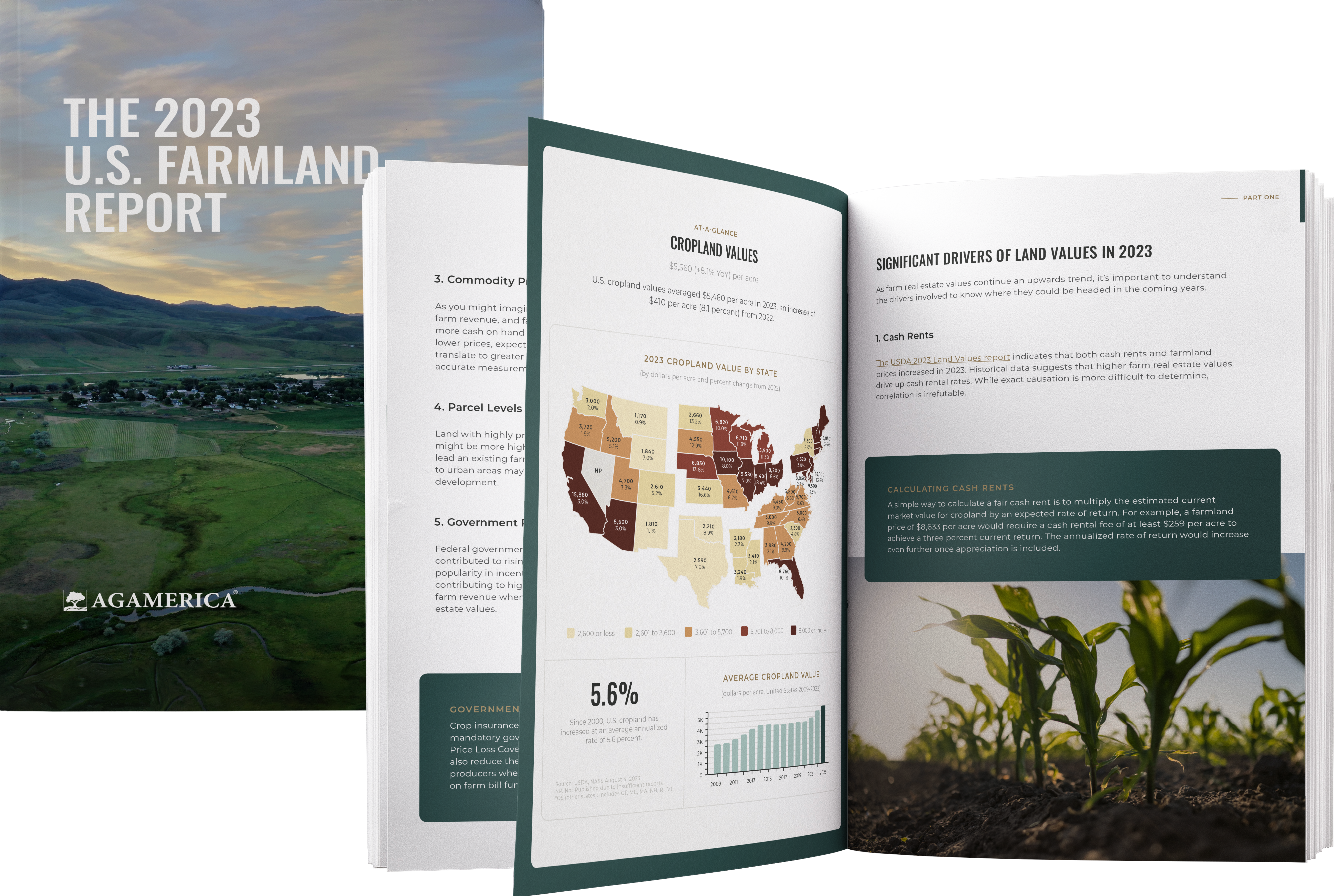Five Factors Driving Farmland Prices in 2023
Despite a global economic slowdown, farmland prices remain on the rise.
Over the past ten years, farmland prices have increased nearly 40 percent. Farm real estate will likely become a nearly $3.5 trillion market in 2023, representing 83.6 percent of total farm sector assets. As the market grows and values rise, it’s important for landowners to understand the power in their equity and how to effectively mitigate risk while seizing opportunity.
AgAmerica’s economic research team analyzed farmland value data to provide the answers to these questions. Download the report for free access to the full results or keep reading to learn highlights recapping 2023 land market trends.
The 2023 Farmland Report
Understanding the power of equity is key in helping farmers mitigate financial risk. Download AgAmerica's free land report to unlock market insights from AgAmerica's economic research team.

The 2023 Farmland Report
Understanding the power of equity is key in helping farmers mitigate financial risk. Download AgAmerica's free land report to unlock market insights from AgAmerica's economic research team.
In this article, we break down why the U.S. farmland market is so strong and what factors are influencing its growth.
U.S. Farmland Prices in 2023
In the U.S. farm sector, real estate accounts for $4 of every $5 in assets. That is what makes it such an important indicator of a farm’s resilience. In 2023, farm real estate increased across the board, with higher average percentage increases for U.S. cropland prices.
Farm Real Estate Prices
Farm real estate is the sum of all land and buildings located on farm property. In 2023, farm real estate value rose $280 per acre to an average of $4,080. That is a 7.4 percent increase year-over-year, just a bit short of the average annual return of 10.74 percent.
Cropland Prices
Cropland values increased $410 per acre to an average of $5,460. That is an 8.1 percent increase year-over-year, outperforming the average annualized rate of 5.6 percent.
Pasture Prices
Pasture and ranch land values increased $110 per acre to an average of $1,760. That is a 6.7 percent increase year-over-year, higher than the average annualized rate of 4.9 percent.
Five Factors Influencing Farmland Prices
Farmland prices are on the rise, but how long can farmers rely on these high levels of appreciation? By keeping an eye on the following factors driving farmland values, farmers can be proactive in anticipating market shifts.
1. Cash Rents
Historically, there has been an observable correlation between farmland values and cash rents. As you might imagine, more expensive farmland naturally leads to higher rent on the land.
More than 75 percent of farmland in the U.S. is owned by an active operator or a retired farmer. For the three quarters of farmers that own their land, high land values provide a financial hedge if the profitability of land declines. However, it places greater financial strain on tenant farmers, who could face higher costs.
2. Interest Rates
In an effort to control inflation, the Federal Reserve passed multiple interest rate hikes in 2023, causing an increase in the 10-year constant maturity rate. Since 1998, the 10-year contact maturity rate and farmland returns have remained in close alignment. With this in mind, many experts agree farmland prices will likely remain stable around current levels over the next few years.
3. Commodity Prices
Commodity prices drive farm income—and consequently, farm revenue and real estate values. However, it’s not a simple one-to-one increase. While it’s true that higher commodity prices generally translate to more cash in the hands of farmers, other factors like rising input costs may reduce net income.
Landowners should track both input costs and commodity prices when tracking farmland prices to help predict budgets and investment expectations.
4. Parcel Levels
Not all farmland is cut from the same cloth. Understanding what can raise farmland value outside of market trends can help you predict if your land might be worth more. Highly productive soil, nearby grain highways, or contiguous land are all factors that may push farmland prices up.
5. Government Policy
There are dozens of government programs that put funds in farmers’ hands. From regenerative farming initiatives to federal crop insurance, many farmers depend on government policy as a source of capital. During the pandemic, farms saw record high farm income due to increased funding to governments programs. With more cash on hand, farmers may be willing to pay more for farmland, pushing values up.
The Farm Bill, a source of many agriculture policies in the U.S., expired on September 30. Unless Congress passes the next bill before the end of the year, many crucial programs may lose their funding, leaving farmers with less risk protection.
Stay Informed on Where Farmland Prices Are Headed
For a farmer that owns their land, that land makes up over 80 percent of their assets. Ensuring that you understand the position of your land’s value and what factors can affect it is crucial to protecting the financial health of your operation. AgAmerica publishes resources designed to keep you in the know of changes in the agriculture industry.
Our 2023 Farmland Report explores farmland values in depth and how landowners can use their equity to invest, expand, and succeed for years to come. Download the report today to unlock exclusive insights from AgAmerica’s economic research team.






